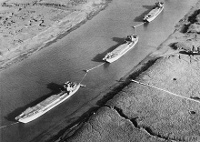Operation Fortitude: D-Day Deception
One of the more successful initiatives employed by the Allies in conjunction with the D-Day invasion was the advent of Operation Fortitude, a sleek act of deception that fooled the German Army for weeks. Begun in 1944, Operation Fortitude proceeded through a variety of means to distract German attention from the buildup of the actual invasion force. The operation had two divisions, promoting fictional invasions of both France and Norway. Allied intelligence let it be known that the invasion of France would take place at Pas-de-Calais, the nearest point to the United Kingdom and that leading that invasion would be America's celebrated General George Patton, at the head of the First United States Army Group. That army was based in Dover, in southeast England, so the story went. Because German spies would no doubt observe the buildup of the real invasion force, more to the west in southern England, the deception efforts went into overdrive and spread information that that was the 21st Army Group, led by British General Bernard Montgomery. The theory went that because Patton was a commander that the Germans most feared, they would naturally believe that he would be at the head of the main invasion force. 
The operation had several elements to give it the appearance of authenticity. The Allies built dummy tanks, planes, and landing craft (right) that were clearly visible to German spies and also constructed buildings and installed road signs and other ground-based suggestions that a large amount of training was going on in and around Dover. Foot and vehicle traffic in the area was stepped up. Radio traffic detailed supposed troop movements in those training scenarios. Photos of Patton in the area were widely publicized. Helping the deception efforts was a Spanish double agent, Juan Pujol Garcia, who fed a great deal of information about the planned attack to his contacts in German intelligence. Also helping in these deception efforts were Romoan Czerniawski, a Polish officer, and Dusan Popov, a Yugoslav lawyer. The overall message that the Germans were supposed to believe was that no matter where other Allied troops landed in France, the main invasion would take place at Calais, in mid-July. That was the message of Operation Fortitude South. A twin deception, Operation Fortitude North, was aimed at convincing German intelligence that the Allies were going to invade Norway. This scenario involved the fictional British Fourth Army training near Edinburgh Castle. This operation proceeded largely through fake radio traffic, including announcements such as sports scores to troops that didn't exist. To seal the deal on Fortitude North, British commandos struck at military outposts in Norway in spring 1944. Operation Fortitude was so successful that the German Army kept 15 reserve divisions near Calais even after the Normandy landings, on June 6, had taken place. They were waiting for the "real" invasion to begin. |
|




